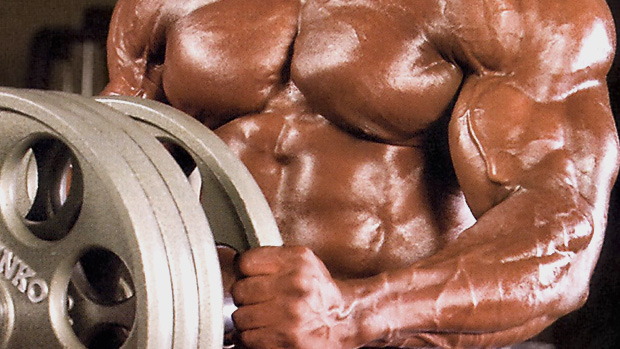Want to get strong? Like, really strong? Then avoid making any of these all-too-common mistakes.
No, we're not judging character. But most of the guys who are teaching other guys how to get strong are weak as kittens, and that just ain't right. Sure, they may know what proper form is, how to manipulate a diet, or how to be fit, but it's not the same as knowing how to create a proper program with the purpose of developing maximal strength.
There's simply too much that must be learned if you want to get someone strong, and I don't think you can learn it all without doing a lot of trial and error on yourself. If a coach won't share at least some of their personal records with you, it should be a warning sign. Now, I'm not saying every coach must be Ed Coan but they should at least be good at the stuff they're trying to coach you on.
One of my favorite quotes sums up my feelings nicely:
"Don't spend much time listening to someone talk about something they have never done."

The good news is if you fix the first mistake, it'll usually take care of the second. Find a coach who knows what they're talking about, who walks the walk, and whose general philosophy sits right with you (Poliquin, Thibaudeau, Cressey, Gallagher, Hatfield, and Bostrom are just a few that come to mind) and follow their programs if you're not making progress on your own.
But here's the thing: you can't change too much right away. Follow their programs as written, at least for a while (several months if not more) before you start to tinker with them to meet your individual needs. Too many people change too many variables too often.
Program hopping often leads to a kind of "starting over" where you perform the first couple of weeks of a program (which is usually an introduction or foundation-building period) and then switch over to something else before the real progress occurs. Changing programs also makes progressive overload more difficult to implement and measure.
Progressive overload, when combined with the principle of specificity, is the single most important element in a program designed to increase muscular strength. The goal is not to do 50 different exercises over the course of a month, but to pick five to ten key exercises and work on them repeatedly to improve strength.
Yeah, this sounds stupid, but a lot of people don't really know why something is in their program; they just put it in because it looks good or they think they're supposed to do it.

Here's an example: one legged squats (pistols as they are sometimes called) don't do jack to increase maximal strength or muscle size; if you grow from doing them then you'd probably grow from doing almost any hard leg work. Why do we know this is true?
Because there are lots of people that weigh 135 pounds soaking wet that can do five good pistols, but if you were to ask them to get under the bar with 275 pounds on their back they'd get buried. And to the best of my knowledge, most of the really good squatters (Anderson, Karworski, Coan, Hamman, Hatfield) never attributed their squatting prowess to a lot of work on one-legged squats. So does this mean that one-legged squats are a waste of time? Not exactly. But they're not for building strength.
What usually happens is a coach thinks that one-legged squats will be good for their athlete to do. So they exaggerate the effect of the exercise and tell them that one-legged squats will make the athlete huge and jacked and help them get laid.
So the athlete spends some time doing them, gets a little better at them, but their actual squat doesn't go up and their legs don't change in size. (Plus they don't do any better with the ladies.) The end result is they think the coach is an idiot and they stop doing the one-legged squats.
I think it would be much better if coaches were just honest about what an exercise does. A one-legged squat can be good for your ankles, knees, and hips and can help keep you healthy and mobile. But that's it.
I also believe that if you know why you're doing something you can focus on the purpose of what it's supposed to achieve. If you think one-legged squats are for getting huge, you'll naturally push yourself and try to use more weight, perhaps at the expense of form. If you think their purpose is to keep you healthy and injury free, then you'll start to focus on technique, hip angle, and knee drift, which, most likely, will be more effective.
I recently started doing more one-armed push-ups. I'm not doing them because I think they'll make my chest huge or because I'll instantly add fifty pounds to my bench. I'm doing them to increase my shoulder stability, which might keep me healthy and may yield a better bench press.
Knowing the purpose of an exercise can help you decide if you should do it, how to program it, and if it's giving you the results you want. That can only help you in the long run.
You can't have a heart to heart talk with your body, but the saying "know thyself" fits best here. As a lifter in the pursuit of strength, at some point you have to start figuring out how your body responds to exercise so you can modify or create programs to meet your goals.
If you're still relatively new to the strength training world (less than five years) I wouldn't fret about this too much; the knowledge will come as long as you're paying attention to what you're doing.
To facilitate the learning, I want you to make a list of ten exercises that you believe, deep in your heart, make you strong. Not what you think other people will say, or what the experts say, but ten exercises that you honestly believe will get you strong. Now look at your program. All of those ten exercises should be what that program is built around.
Strength athletes are usually focused on the positive (concentric) portion of the exercise, which makes sense. They also like to explode on the concentric, pushing it as hard as they can.
But since exploding the weight up is tiring, the athlete often "takes a break" on the negative (eccentric) portion of the lift and lets the bar drop into position. A lot of athletes also like to take advantage of the stretch reflex that a drop in the last several inches of the range of motion will provide.
I believe that as your concentric strength begins to get closer to your eccentric strength, or if you start to feel at some point in the negative portion of the exercise you couldn't stop the weight if you wanted to, then doing some more negatives would be a great idea.
But you can't just load up a bar with a shit-ton of weight and start lowering it; I like to do my negatives a little differently than most.
Most of the time people go super-heavy–well over their 1RM–and they do only one negative rep that's four to six seconds long. I never found that method to be particularly effective for me.
Instead, I do negatives more along the lines of what Arthur Jones suggests.
I pick a weight I can lower for at least ten seconds, have a partner help me lift it back up, and do as many reps as I can with that weight, lowering as slowly as possible with every rep. I stop the set when I can no longer control the weight for at least three seconds.
While I don't want you to get hung up on the percentages, I usually use between 75-85 percent of my 1RM on this technique and usually get between four to eight reps.
Just remember that it's a "negative only" set; you must have a partner help you with the lifting portion of the rep. I would also not advise doing these on squats, deadlifts, or cleans, but they seem to work well for bench, pull-ups, most machine work, curls, and sit-ups.
Adding in one or two negative sets as described at the end of the main exercise for the day seems to work well and can rapidly improve your strength.
If you can avoid making these common mistakes and combine that with intense training, progressive overload, and good exercise selection, you may just find yourself stronger than you ever thought possible.




